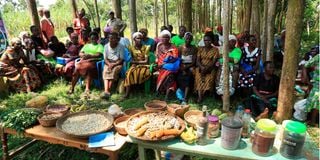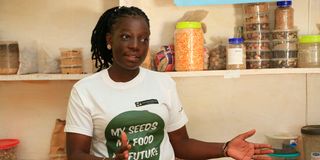Premium
Why farmers in Western Kenya are turning to seed banks

Musand residents follow proceedings during a Mashinani Seed Fair in Kakamega on October 5,2024.
What you need to know:
- Inside the bank are neatly arranged shelves with indigenous seeds stored in glass containers.
- Outside the bank is a field plot where trees or crops without seeds are grown for conservation.
A group assembles under a tree at a compound in Ebuchirinya village, Kakamega County, on a Saturday morning. On a wall of one the houses are the words: “Mumias West Framers Seed Bank”.
Seeds of Gold team and Ebuchirinya Seed Bank Secretary Hellen Khaemba make their way to the building. Before we step in, she asks us to observe a minute of silence.
“This is to think about indigenous seeds that are extinct or becoming rare,” Khaemba says.
Inside the bank, located in Mumias West constituency, are neatly arranged shelves with indigenous seeds stored in glass containers that are marked with names of the owners and phone numbers.
The seeds include bean, soya, maize, popcorn, groundnuts, sorghum and millet, all in different varieties. There are more than 50 indigenous seed varieties.
“This is where we have been storing our indigenous seeds since 2020 when we launched the programme,” Khaemba says, adding that the seeds are stored free of charge.
Outside the bank is a field plot where trees or crops without seeds are grown for conservation.
Here, the group has planted cassava, arrowroots, sugarcane, pine apples, sweet potatoes, medicinal plants and others.
Khaemba says they used to store the seeds at household level before establishing the bank. She would dry the seeds and store them in jerrycans. Unfortunately, mos of the seeds would rot.
“During dry spells, the seeds would also be converted to food,” she says, adding that visitors would be given seeds as gifts.
Khaemba says it is important to store seeds for the planting season since many families cannot afford hybrids.
“The price of hybrid seeds continues to rise while families barely have enough for basics,” she says.
In 2020, the group members were brought together and helped to form the bank by the Seed Savers Network Kenya, a national grassroots organisation.
Ebuchirinya Seed Bank Chairman, Stafron Makokha, says members got training on seed selection and storage.
The bank stores seeds for more than 100 farmers. The farmers meet at least once a month for training by seed ambassadors or experts from the Seed Savers Network. When brought for storage, the seeds are weighed and their moisture content tested.
“To know the moisture content, the seeds are placed in a glass bottle with salt and shaken. They are then left to rest for 24 hours,” says Makokha, adding that if they are attached to salt particles, they are not dry enough.
Those found dry are put in containers that are then marked with the owner’s details and placed on the shelves where they can remain for a year.
While at the bank, the seeds undergo germination tests every four months.
“This involves planting some of the seeds. If they grow, it means they are alive and are returned to for storage,” Makokha says.
Group members have been trained to identify seeds with desirable characteristics, including adaptability to climate change, resistance to pests and diseases and healthy growth.
Indigenous crops can withstand harsh weather and grow without the input of chemicals.
Makokha says one of the advantages of seed banks is that they enable farmers to network and exchange seeds. Laws in Kenya do not support sale of indigenous seeds.
He explains that farmers are encouraged to plant the stored seeds while preserving some portion to increase their availability.
“Our aim is to preserve as many seeds as possible. This can only be done if we keep planting them,” he says.
A few kilometres away, Patricia Ngesa has joined fellow villagers at a community seed fair in Emurere village.
Tens of farmers attend the event, eager to learn about indigenous foods and exchange seeds.
On display are a variety of ready foods, African leafy vegetables, fruits, medicinal plants and tubers.
The farmers have a chance to show those around how the foods are prepared.
“We recently started a seed bank,” Ngesa says.
Seed Savers Network Kenya Programmes Officer, Mercy Ambani, says the grassroots organisation works with smallholder farmers in Western Kenya.
The organisation has been working with farmers in Siaya, Kisumu, Kakamega, Vihiga and Bungoma counties and helped establish more than 24 seed banks since 2009.
She explains that Seed Savers Network Kenya has partnered with the German International Cooperation (GIZ) and is putting up nine more seed banks.
Seed Savers Network Kenya has established 13 banks benefiting more than 700 farmers in Kakamega County.

Seeds Savers Network Kenya Programmes Officer Mercy Ambani during an interview at Mumias West Farmers Seed Bank.
“We are targeting more than 2,000 farmers for now,” Ambani says, adding that the organisation only helps put up banks for farmers already engaged in conserving traditional seeds.
During the monthly meetings, the farmers get training on agro-ecology, including how to safely use organic fertiliser and pesticides.
Ngesa says the organisation has also trained group members on vermicomposting and seed production, selection and preservation.
“We have up to seven varieties of indigenous maize, nine varieties of traditional leafy vegetables,15 bean varieties and other seeds,” Ambani says, adding that once an indigenous seed variety is in the bank, seed ambassadors like Khaemba are sent out to trace larger quantities from farmers.





